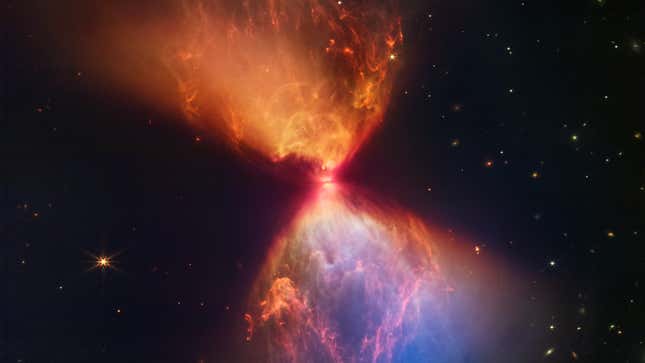
NASA officials spoke at a House subcommittee hearing Wednesday morning about the status of the Webb Space Telescope, which has been capturing images of the universe near and far since early this summer. During the meeting, they revealed Webb’s latest portrait: a shot of a dark cloud called L1527 and the light emanating from a protostar at its core.
L1527 is about 460 light-years from Earth and stretches 0.3 light-years across. At its center there is a protostar, a very young star that is still forming. The cloud was previously imaged by the Spitzer Space Telescope and the ALMA radio telescope, which revealed the distinctive hourglass shape. But it’s never been seen with the crisp resolution that Webb has managed using its Near-Infrared camera, or NIRcam.
“This first image of this protostar with JWST shows that, while the protostar itself is hidden, within the neck of this hourglass shape, you see a protoplanetary disk—there’s a dark line across the middle of the neck,” Mark Clampin, the Astrophysics Division Director NASA’s Science Mission Directorate, told the subcommittee.
“To the top and the bottom, you see light from the protostar illuminating the cavities within the surrounding outflows of gas and dust from this object,” Clampin added.
L1527 is viewed edge-on, which means that the narrow end of the disk of material surrounding the protostar is facing Webb. Bubble-like shapes in the upper region of the image are stellar “burps,” or ejections of material, according to a Space Telescope Science Institute release. The lower right region appears blue instead of orange because there is less dust between it and Webb.

Besides the image reveal, NASA officials gave an overall report on Webb’s scientific progress, the current state of the telescope, and what comes next in the space agency’s study of the universe.
Today’s hearing “may be tied with the gravitational waves hearing as the most fascinating we’ve had,” said Don Beyer, the representative for Virginia’s 8th district.
Clampin said there have been 14 micrometeoroid strikes on Webb to date, one of which was particularly large. “We expected this, and we’re being very conservative and making some operational changes to make sure we avoid any future impacts,” Clampin said.
Besides questions about the mission’s expected longevity and technical glitches with its instruments, the hearing was an opportunity for Congresspeople to ask general questions about astrophysics and the cosmos.
Bill Posey, the representative for Florida’s 8th District, wanted to know what came before the universe.
“My favorite answer to that is, your guess is as good as mine,” said Steven Finkelstein, an astronomer at UT Austin and the principal investigator of Webb’s Early Science Release results. “A more technical answer, which I don’t like, is that the concept of time only exists as long as the universe exists. So there was no before.”
While what came before the Big Bang remains the realm of theory, NASA has plans to understand observe where we’re going. Chief among NASA’s priorities beyond Webb is the Roman Space Telescope, which will primarily investigate dark energy—the unknown driver of the universe’s accelerating expansion.
Webb’s operational lifetime in space is still estimated to be about 20 years, Clampin said. If Webb continues producing imagery at its current pace, we’re in for a real treat. And then another. And another.
More: Webb Telescope Shows the Pillars of Creation Like You’ve Never Seen Them Before